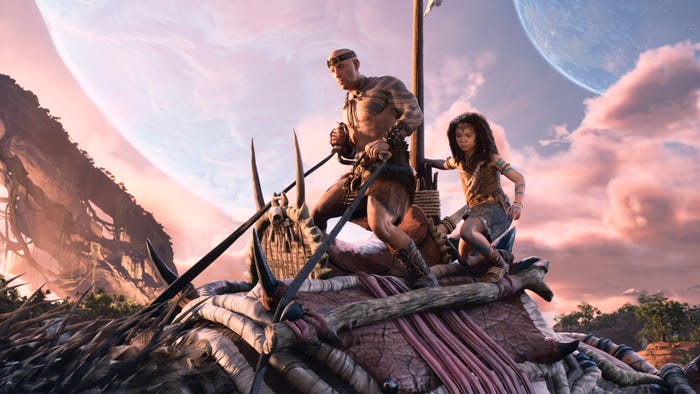Analysis: Storyteller And Game Narrative
In an in-depth new analysis piece, writer and game designer Emily Short looks at Dan Benmergui's Storyteller playable Flash story experiment, and exactly what it tells game developers about the state and structure of game narrative.

[In an in-depth new analysis piece originally printed on Gamasutra sister website GameSetWatch, writer and game designer Emily Short looks at Dan Benmergui's Storyteller playable Flash story experiment, and exactly what it tells game developers about the state and structure of game narrative.] Storyteller is a charming toy by Dan Benmergui. It gives the player three windows onto the same events, a vertical triptych. The player manipulates the first two scenes, moving characters around in a way that indicates their alliances. The third panel reflects the outcome, the result of the player's manipulations. This is not a game, because there are no goals. I hesitate to say that what it produces are really stories, either: at best, we wind up with a somewhat terse comic strip in which most of the linking explanation is left to the player to choose for himself. Despite that, the elements of narrative are here. There is a beginning, and it determines future character: people who grow up in the castle turn out good, while those who grow up impoverished in a hut turn out bad. There is a middle, the crisis, where the most fluidity is possible. Characters can be locked up, can kill one another, can stand around peaceably; it all depends on whether their mores are in conflict at that point, and on who has the physical advantage. There is an end. Those who were killed in the previous scene now are dead (represented by small tombstones). Those who rescued, or were rescued, may now be in love. (Shared hardship is, evidently, a great determiner of affection.) Good or evil may rule the land. Out of the simple combinations come a range of amusing outcomes. For instance, the game's story-logic doesn't care about gender; there is nothing to stop you from setting up a gay romance in which the female character grows up to be an evil wizard and one male character must rescue the other. But still: at the end of the day, it isn't a game; it's a toy, and a small one. Benmergui casts it as an experiment. It's less lyrical than I Wish I Were the Moon, or The Night Raveler and the Heartbroken Uruguayans, both of which explore characters who long for connection, and grant the player godlike powers to allow or destroy this connection. Where I wish... and Night Raveler explore the unlikely through poetic imagery, Storyteller works through and because of its clichés. Does it have anything to tell us about interactive storytelling? If so, what it has to say is probably this: Explicit structure matters. Storyteller allows us to change almost everything about the outcome of its storyworld, but it contrains us to three episodes: set-up, crisis, outcome. This is an approach that can be applied productively in less constrained kinds of interactive storytelling. It's a different model than the model of narrative that branches according to player choice (a model which requires sometimes unrealistic amounts of content-production). It's different from a generative model like Facade, which (while ambitious and brilliant) can produce shapeless-seeming results for the player. The structure-first model of interactive story-telling is one in which the author designs for a certain number of important episodes, but allows for each of those episodes to contain a great deal of procedural variation depending on the player's choices. It allows for freedom and agency without sacrificing form. And note the word "explicit". Façade has a model that internally tries to design for building action, crisis, and resolution (at least as I understand it) — but that model is not visible to the player, which means that a playthrough of Façade can seem a bit formless. Clues to structure — even if they're as generic as marking that the first act is now over — help the player understand the story as something with a definite shape. They can even give a bit of guidance on how the player should be acting now. I've written a structure-first game myself: it was a re-envisioning of Sierra's Mystery House, an illustrated text adventure in which you and several other legacy hunters are alone in a house with a killer. Bodies pile up rapidly while you hunt for the heirloom jewels and try to work out who is responsible. The original game doesn't allow for any variation in who the killer is, and there's not much you can do to stop the carnage. In my version, Mystery House Possessed, I was interested in introducing some randomization in the mix: the killer is picked at random at the start of play, and clues are selected partly in response to the killer's identity and motive. No matter how the player acted, the play would be punctuated by death scenes until the player was alone with the killer. The only way to change that narrative shape was to bring it to an early end by identifying the murderer and winning. On the other hand, the details of those scenes could change materially, depending on who the murderer was, who was still alive, what clues had been left behind, and what relationships existed between the player and the characters. I bring up this example not because I think Mystery House Possessed is the best possible execution of the structured model — the same thing could be done a lot better than I did it — but because I found it remarkably freeing to write in this mode. For any given scene, I could ask not "what happens now as a result of player actions?" (which is scarily broad) and not "how can I shoehorn the player's actions so far into my story?" (which often produces hacky results) but "given the current world-state, who is best to play the important roles in this scene, and how would that person perform that function?" I don't want to oversell this. There are lots of different models how to generate a good story, which go in and out of vogue as people try them out and discover their problems. The strengths of the structure-first model can also be weaknesses. On the first play-through, the player sees the story unfolding apparently organically; on the third, he's pretty well worked out how the bones of the story are arranged, and the whole trick seems considerably less clever. Nonetheless, the advantages are real. You get to constrain your design problem a bit, which makes it easier to solve. You get to tap into the player's inherent story-telling ability by giving him a shape to work with. You get to focus all your procedural-content-generating energy on producing compelling variations within that structure. And Storyteller makes an appealing short-form demonstration of how it's done. [Emily Short is an interactive fiction author and part of the team behind Inform 7, a language for IF creation. She also maintains a blog on interactive fiction and related topics. She can be reached at emshort AT mindspring DOT com.]
About the Author(s)
You May Also Like













